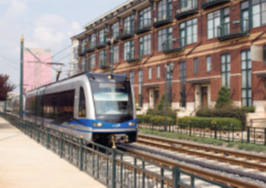|
Alstom and Huawei Announce the First Live Fourth-Generation Pilot
for Communications-Based Train Control—On 6 August 2014,
Alstom and Huawei announced a long-term evolution (LTE) fourth-generation (4G) pilot
for the metro market to demonstrate the performance of a multiservice broadband
radio network for communications-based train control (CBTC). Alstom has been
working on LTE since the technology has been available from the telecom
industry. This pilot will use Huawei's LTE technology following the memorandum of
understanding (MoU) signed by the two companies in April 2014.
 Alstom and Huawei will test the new equipment on railroad tracks at
Alstom’s Valenciennes site in France. Huawei is providing the LTE network and
Alstom is providing the train and LTE-compliant onboard equipment. With LTE,
rail customers benefit from the wireless infrastructure that provides
mission-critical voice communication, secure train signaling in accordance with
the CBTC standards, and broadband data communication such as live video
streaming of surveillance cameras and passenger information systems. This
solution complements Alstom’s proprietary Urbalis2 CBTC solution. Huawei’s LTE
solution has already been successfully deployed in a number of rail projects.
The integration with Alstom’s Urbalis solution highlights the potential of LTE
as a converged network for rail operations. Alstom and Huawei will test the new equipment on railroad tracks at
Alstom’s Valenciennes site in France. Huawei is providing the LTE network and
Alstom is providing the train and LTE-compliant onboard equipment. With LTE,
rail customers benefit from the wireless infrastructure that provides
mission-critical voice communication, secure train signaling in accordance with
the CBTC standards, and broadband data communication such as live video
streaming of surveillance cameras and passenger information systems. This
solution complements Alstom’s proprietary Urbalis2 CBTC solution. Huawei’s LTE
solution has already been successfully deployed in a number of rail projects.
The integration with Alstom’s Urbalis solution highlights the potential of LTE
as a converged network for rail operations.
CityLYNX Gold Line Advances in Charlotte, North Carolina—Charlotte’s new CityLYNX Gold Line streetcar line started
on-street testing on 10 April 2015 and was scheduled to open in June. The first
phase of the CityLYNX Gold Line will be free to ride and runs 1.5 mi from the
Charlotte Transportation Center to Novant Health Presbyterian Medical Center.
It has six stops and will use existing replica trolley vehicles. The first
segment cost US$37 million to build, with US$25 million paid for by a federal
grant. The second phase will extend the line to Johnson C. Smith University to
the west and the Elizabeth neighborhood to the east, a total of 2.5 mi, creating
a system that covers 4 mi in total. The agency anticipates advancing the
project as a design, bid, and build project in early 2016. Construction for the
second phase is projected to begin in late 2016 with service projected to start
in late 2019.
Read the full article in IEEE Vehicular Technology
Magazine, Volume 10, Issue 3, September 2015. |